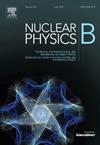六维轻子的电弱理论
IF 2.8
3区 物理与天体物理
Q2 PHYSICS, PARTICLES & FIELDS
引用次数: 0
摘要
我们提出了一种扩展到六维的轻子扇区中的电弱相互作用理论。这种扩展涉及到在标准四维理论中添加两个额外的类时维度,从而得到一个六维时空,对应于克利福德代数C(3,3)。用C(3,3)的矩阵表示从它的元素构造洛伦兹不变量。我们证明了C(3,3)的三个特定元素足以描述单代的八个轻子态。使用这些元素,我们定义了SU(2)×U(1)的表示,从而得出了包含相互作用的手性性质的电弱理论。我们的结果表明,在额外的类时维上规范玻色子的分量形成了渐变超代数su(4|4),它为W玻色子的额外维分量产生了二次项和四次项。这些术语促进了真空期望值和自发对称破缺,为希格斯势提供了一种新的解释。根据这个势,我们预测树能级的希格斯质量为真空期望值的一半,即mH=123.11 GeV。此外,该模型预测θW=30°的温伯格角。这种方法与先前利用内部规范对称和超代数(如su(2|1)或su(2|2))的模型形成对比,通过直接从C r(3,3)的时空几何中推导出超代数su(4|4)。本文章由计算机程序翻译,如有差异,请以英文原文为准。
An electroweak theory of leptons in six dimensions
We present a theory of electroweak interactions in the lepton sector extended to six dimensions. This extension involves adding two additional time-like dimensions to the standard four-dimensional theory, resulting in a six-dimensional spacetime corresponding to the Clifford algebra Cℓ(3,3). A matrix representation of Cℓ(3,3) is used to construct Lorentz invariant quantities from its elements. We demonstrate that three specific elements of Cℓ(3,3) are sufficient to describe the eight lepton states of a single generation. Using these elements, we define a representation of SU(2)×U(1), leading to an electroweak theory that incorporates the chiral nature of the interactions. Our results show that components of the gauge bosons in the extra time-like dimensions form the graded superalgebra , which generates quadratic and quartic terms for the extra-dimensional components of the W bosons. These terms facilitate a vacuum expectation value and spontaneous symmetry breaking, providing a novel interpretation of the Higgs potential. We predict a tree-level Higgs mass from this potential to be half the vacuum expectation value, or GeV. Furthermore, the model predicts a Weinberg angle of . This approach contrasts with previous models that utilized internal gauge symmetries and superalgebras like or , by deriving the superalgebra directly from the spacetime geometry of Cℓ(3,3).
求助全文
通过发布文献求助,成功后即可免费获取论文全文。
去求助
来源期刊

Nuclear Physics B
物理-物理:粒子与场物理
CiteScore
5.50
自引率
7.10%
发文量
302
审稿时长
1 months
期刊介绍:
Nuclear Physics B focuses on the domain of high energy physics, quantum field theory, statistical systems, and mathematical physics, and includes four main sections: high energy physics - phenomenology, high energy physics - theory, high energy physics - experiment, and quantum field theory, statistical systems, and mathematical physics. The emphasis is on original research papers (Frontiers Articles or Full Length Articles), but Review Articles are also welcome.
 求助内容:
求助内容: 应助结果提醒方式:
应助结果提醒方式:


